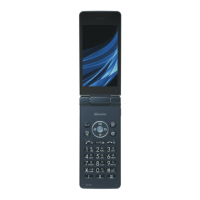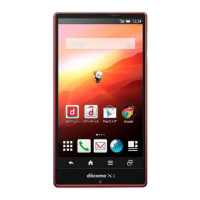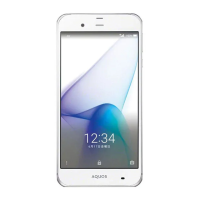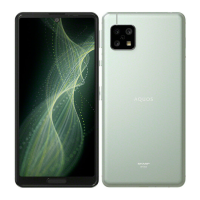Do you have a question about the Sharp Aquos SH-02K and is the answer not in the manual?
Describes methods for checking handset operation, including guides and manual formats.
Lists components like Back Cover, Battery Pack, Desktop Holder, and Quick Start Guide.
Details physical parts of the handset and their functions.
Explains fundamental operations like using the handset, charging, and power management.
Lists various settings accessible via the Settings menu, including wallpaper, sound, security, network, and docomo service.
Covers managing handset memory, microSD card, and operating files.
Details on infrared, Bluetooth, and NFC communication methods.
Discusses reliance on radio signals, signal strength, and service areas for optimal performance.
Details UIM card requirements and supported network providers.
Advises reading precautions carefully to prevent injury and damage.
Explains symbols like DANGER and WARNING indicating severity of risks.
Warns against touching terminals with metal objects and using excessive force when fitting/removing.
Instructs to stop using if battery leaks or emits odor, and to move away from flames.
Details immediate actions if internal substance contacts eyes or mouth, advising medical care.
Warns against aiming infrared port at eyes or appliances and viewing flickering screens.
Details SH-02K's waterproof (IPX5, IPX8) and dustproof (IP5X) ratings and MIL standard compliance.
Advises on securely closing the back cover to maintain waterproof/dustproof performance.
Provides numbered steps for placing and securing the back cover onto the handset.
Details how to remove the back cover by pressing and hooking a finger into the slot.
Advises checking if handset is wet or soiled before and after charging.
Strongly warns against connecting microUSB plug when handset is wet to prevent short circuits and fire.
Explains how to navigate and select items using the cursor keys and center key.
Describes how to navigate and select items from the Normal and Simple menus.
Details elements like status bar, notification counters, clock/calendar, Machi-Chara, and pedometer.
Guides on activating and using focus mode for status bar items and its limitations.
Explains how notification counters appear and how to check details for missed calls, new mail, etc.
Lists and explains main notification icons like New SMS, New mail, and Error.
Differentiates between notification icons (memos, SMS) and status icons (battery, signal).
Lists and explains various status icons, including battery level and signal strength.
Lists network services like Voicemail, Call forwarding, and Call waiting.
Covers settings for Remote operation and Public mode (power OFF).
Options for setting ringtone start time, rejection SMS, quick silent, and operation when opened.
Guides on setting call rejection for specified callers, unregistered, anonymous, payphone, or unknown numbers.
Step-by-step process for adding new contacts or adding to existing ones.
Details on entering first name, last name, phone, mail, favorites, and groups.
Information on sending/receiving emails via DOCOMO mail and data transfer.
Step-by-step guide for composing and sending docomo emails.
Guides on sending and receiving SMS with mobile numbers and overseas network operators.
Explains how messages are grouped by threads and displayed with sender/destination info.
Explains how to display websites via packet communication and Wi-Fi.
Covers reloading pages, changing volume, zoom, font size, and displaying page info.
Instructions on saving bookmarks and displaying them for quick access.
Information on playing music data, playlists, and supported file formats.
Guides on adjusting volume, playing music data, and rewinding/fast-forwarding.
Guides on setting alarm tone or vibration at a specified time, including name, repeat, sound, and vibration.
Explains snooze settings and how to stop sounding alarms.
Guides on creating, checking, and managing schedule events.
Details operations on the schedule screen, like displaying events and jumping between months.
Guides on displaying maps, searching for locations, and using map submenus.
Details on entering location information or selecting categories to search.
Guides on recording steps, distance, calories, and viewing walk history graphs.
Covers changing user information, setting goals, and resetting data.
Explains importing previous phone data and backing up/restoring handset data using microSD Card.
Guides on initiating data saving to microSD Card or importing data via various methods.
Instructions for backing up phonebook, docomo mail, images, etc., to microSD Card.
Guides on restoring backup files from microSD Card to the handset.
Explains how to quickly back up schedule, memo, ToruCa, and other data with automatic updates.
Guides on accessing the instruction manual via the menu and searching by index or keyword.
Guides on adding, moving, peeling off, and changing the size of widgets.
Explains how to use the voice recorder for memos, talks, or negotiations.
Guides on starting recording, selecting subjects, and saving recorded data.
Explains Osaifu-Keitai functions for payments, coupons, and accessing information via NFC.
Discusses handset malfunctions causing data loss and contacting service providers.
Explains NFC technology and Android Beam for sending/receiving data between NFC devices.
Details precautions for using Android Beam, including device positioning and data transfer limitations.
Explains the service for registering/checking well-being information during large-scale disasters.
Details the service for delivering voice messages during disasters and recording caller messages.
Explains Area Mail for receiving earthquake/tsunami warnings and disaster information.
Lists conditions under which Area Mail cannot be received, such as during international roaming or software updates.
Guides on placing restrictions on handset functions to reduce battery usage.
Details on enabling energy saving, viewing overview, and advanced settings.
Information on WORLD WING service for using the same number overseas and available networks.
Details on supported networks (LTE, 3G, GSM) and frequencies for international roaming.
Guides on setting data roaming to ON for packet communication while roaming.
Explains how to check and select preferred network modes (4G/3G/GSM) for optimal connection.
Guides on searching for and selecting available network operators manually or automatically.
Provides contact information for inquiries regarding lost/stolen handsets or service cancellations.
Explains using International Dial Assist for simple international calls from overseas.
Guides on setting up automatic conversion for international prefixes and country codes.
Guides on checking network connection after returning to Japan and adjusting settings if needed.
Lists functions and pages for the normal menu structure.
Lists mail-related functions and their corresponding pages.
Lists web-related functions and their corresponding pages.
Lists Anshin services like Disaster Message Board and Energy Saving with page numbers.
Guides on checking battery installation and charge when the handset does not turn on.
Explains how to forcibly turn off the handset and precautions for data loss.
Advises on improving symptoms by activating safe mode or uninstalling apps.
Warns against modifying the handset or using non-standard accessories due to safety risks.
Advises against peeling the nameplate and notes potential data clearing upon repair.
Explains available update methods: Auto-update, Now update, and Reserve update.
Advises on backing up important data before updating and not removing the battery pack during the process.
Lists cases where software cannot be updated, such as during calls or low battery.
Guides on updating software immediately via rewrite notice screen or menu.
Details the automatic rewrite process and key operations availability during update.
Guides on changing the time for software rewrite and installing update files.
Explains what happens when the reserved time arrives, including update abortion scenarios.
Lists product name, size, weight, memory, and continuous talk/stand-by times.
Details display types, sizes, pixels, and memory capacity.
Explains SAR compliance with Japanese and international guidelines for radio wave exposure.
Details SAR limits for mobile phones and test values for head and body usage.
Discusses SAR measurement, power level changes, and body-worn operation guidelines.
Explains FCC RF emission limits and SAR measurement for wireless handsets.
Details FCC RF exposure guidelines for body-worn operation and accessory requirements.
Warns against using non-specified parts, which may cause fires, burns, or electric shock.
Advises against throwing battery packs into fire or disposing of them in ordinary garbage.
Contact information for DOCOMO Information Center, including business hours and service availability.
Contact information for inquiries from overseas regarding loss, theft, or connection issues.
Steps for inserting a non-DOCOMO SIM card and entering the SIM unlock code.
Describes methods for checking handset operation, including guides and manual formats.
Lists components like Back Cover, Battery Pack, Desktop Holder, and Quick Start Guide.
Details physical parts of the handset and their functions.
Explains fundamental operations like using the handset, charging, and power management.
Lists various settings accessible via the Settings menu, including wallpaper, sound, security, network, and docomo service.
Covers managing handset memory, microSD card, and operating files.
Details on infrared, Bluetooth, and NFC communication methods.
Discusses reliance on radio signals, signal strength, and service areas for optimal performance.
Details UIM card requirements and supported network providers.
Advises reading precautions carefully to prevent injury and damage.
Explains symbols like DANGER and WARNING indicating severity of risks.
Warns against touching terminals with metal objects and using excessive force when fitting/removing.
Instructs to stop using if battery leaks or emits odor, and to move away from flames.
Details immediate actions if internal substance contacts eyes or mouth, advising medical care.
Warns against aiming infrared port at eyes or appliances and viewing flickering screens.
Details SH-02K's waterproof (IPX5, IPX8) and dustproof (IP5X) ratings and MIL standard compliance.
Advises on securely closing the back cover to maintain waterproof/dustproof performance.
Provides numbered steps for placing and securing the back cover onto the handset.
Details how to remove the back cover by pressing and hooking a finger into the slot.
Advises checking if handset is wet or soiled before and after charging.
Strongly warns against connecting microUSB plug when handset is wet to prevent short circuits and fire.
Explains how to navigate and select items using the cursor keys and center key.
Describes how to navigate and select items from the Normal and Simple menus.
Details elements like status bar, notification counters, clock/calendar, Machi-Chara, and pedometer.
Guides on activating and using focus mode for status bar items and its limitations.
Explains how notification counters appear and how to check details for missed calls, new mail, etc.
Lists and explains main notification icons like New SMS, New mail, and Error.
Differentiates between notification icons (memos, SMS) and status icons (battery, signal).
Lists and explains various status icons, including battery level and signal strength.
Lists network services like Voicemail, Call forwarding, and Call waiting.
Covers settings for Remote operation and Public mode (power OFF).
Options for setting ringtone start time, rejection SMS, quick silent, and operation when opened.
Guides on setting call rejection for specified callers, unregistered, anonymous, payphone, or unknown numbers.
Step-by-step process for adding new contacts or adding to existing ones.
Details on entering first name, last name, phone, mail, favorites, and groups.
Information on sending/receiving emails via DOCOMO mail and data transfer.
Step-by-step guide for composing and sending docomo emails.
Guides on sending and receiving SMS with mobile numbers and overseas network operators.
Explains how messages are grouped by threads and displayed with sender/destination info.
Explains how to display websites via packet communication and Wi-Fi.
Covers reloading pages, changing volume, zoom, font size, and displaying page info.
Instructions on saving bookmarks and displaying them for quick access.
Information on playing music data, playlists, and supported file formats.
Guides on adjusting volume, playing music data, and rewinding/fast-forwarding.
Guides on setting alarm tone or vibration at a specified time, including name, repeat, sound, and vibration.
Explains snooze settings and how to stop sounding alarms.
Guides on creating, checking, and managing schedule events.
Details operations on the schedule screen, like displaying events and jumping between months.
Guides on displaying maps, searching for locations, and using map submenus.
Details on entering location information or selecting categories to search.
Guides on recording steps, distance, calories, and viewing walk history graphs.
Covers changing user information, setting goals, and resetting data.
Explains importing previous phone data and backing up/restoring handset data using microSD Card.
Guides on initiating data saving to microSD Card or importing data via various methods.
Instructions for backing up phonebook, docomo mail, images, etc., to microSD Card.
Guides on restoring backup files from microSD Card to the handset.
Explains how to quickly back up schedule, memo, ToruCa, and other data with automatic updates.
Guides on accessing the instruction manual via the menu and searching by index or keyword.
Guides on adding, moving, peeling off, and changing the size of widgets.
Explains how to use the voice recorder for memos, talks, or negotiations.
Guides on starting recording, selecting subjects, and saving recorded data.
Explains Osaifu-Keitai functions for payments, coupons, and accessing information via NFC.
Discusses handset malfunctions causing data loss and contacting service providers.
Explains NFC technology and Android Beam for sending/receiving data between NFC devices.
Details precautions for using Android Beam, including device positioning and data transfer limitations.
Explains the service for registering/checking well-being information during large-scale disasters.
Details the service for delivering voice messages during disasters and recording caller messages.
Explains Area Mail for receiving earthquake/tsunami warnings and disaster information.
Lists conditions under which Area Mail cannot be received, such as during international roaming or software updates.
Guides on placing restrictions on handset functions to reduce battery usage.
Details on enabling energy saving, viewing overview, and advanced settings.
Information on WORLD WING service for using the same number overseas and available networks.
Details on supported networks (LTE, 3G, GSM) and frequencies for international roaming.
Guides on setting data roaming to ON for packet communication while roaming.
Explains how to check and select preferred network modes (4G/3G/GSM) for optimal connection.
Guides on searching for and selecting available network operators manually or automatically.
Provides contact information for inquiries regarding lost/stolen handsets or service cancellations.
Explains using International Dial Assist for simple international calls from overseas.
Guides on setting up automatic conversion for international prefixes and country codes.
Guides on checking network connection after returning to Japan and adjusting settings if needed.
Lists functions and pages for the normal menu structure.
Lists mail-related functions and their corresponding pages.
Lists web-related functions and their corresponding pages.
Lists Anshin services like Disaster Message Board and Energy Saving with page numbers.
Guides on checking battery installation and charge when the handset does not turn on.
Explains how to forcibly turn off the handset and precautions for data loss.
Advises on improving symptoms by activating safe mode or uninstalling apps.
Warns against modifying the handset or using non-standard accessories due to safety risks.
Advises against peeling the nameplate and notes potential data clearing upon repair.
Explains available update methods: Auto-update, Now update, and Reserve update.
Advises on backing up important data before updating and not removing the battery pack during the process.
Lists cases where software cannot be updated, such as during calls or low battery.
Guides on updating software immediately via rewrite notice screen or menu.
Details the automatic rewrite process and key operations availability during update.
Guides on changing the time for software rewrite and installing update files.
Explains what happens when the reserved time arrives, including update abortion scenarios.
Lists product name, size, weight, memory, and continuous talk/stand-by times.
Details display types, sizes, pixels, and memory capacity.
Explains SAR compliance with Japanese and international guidelines for radio wave exposure.
Details SAR limits for mobile phones and test values for head and body usage.
Discusses SAR measurement, power level changes, and body-worn operation guidelines.
Explains FCC RF emission limits and SAR measurement for wireless handsets.
Details FCC RF exposure guidelines for body-worn operation and accessory requirements.
Warns against using non-specified parts, which may cause fires, burns, or electric shock.
Advises against throwing battery packs into fire or disposing of them in ordinary garbage.
Contact information for DOCOMO Information Center, including business hours and service availability.
Contact information for inquiries from overseas regarding loss, theft, or connection issues.
Steps for inserting a non-DOCOMO SIM card and entering the SIM unlock code.
| Brand | Sharp |
|---|---|
| Model | Aquos SH-02K |
| Category | Cell Phone |
| Language | English |












